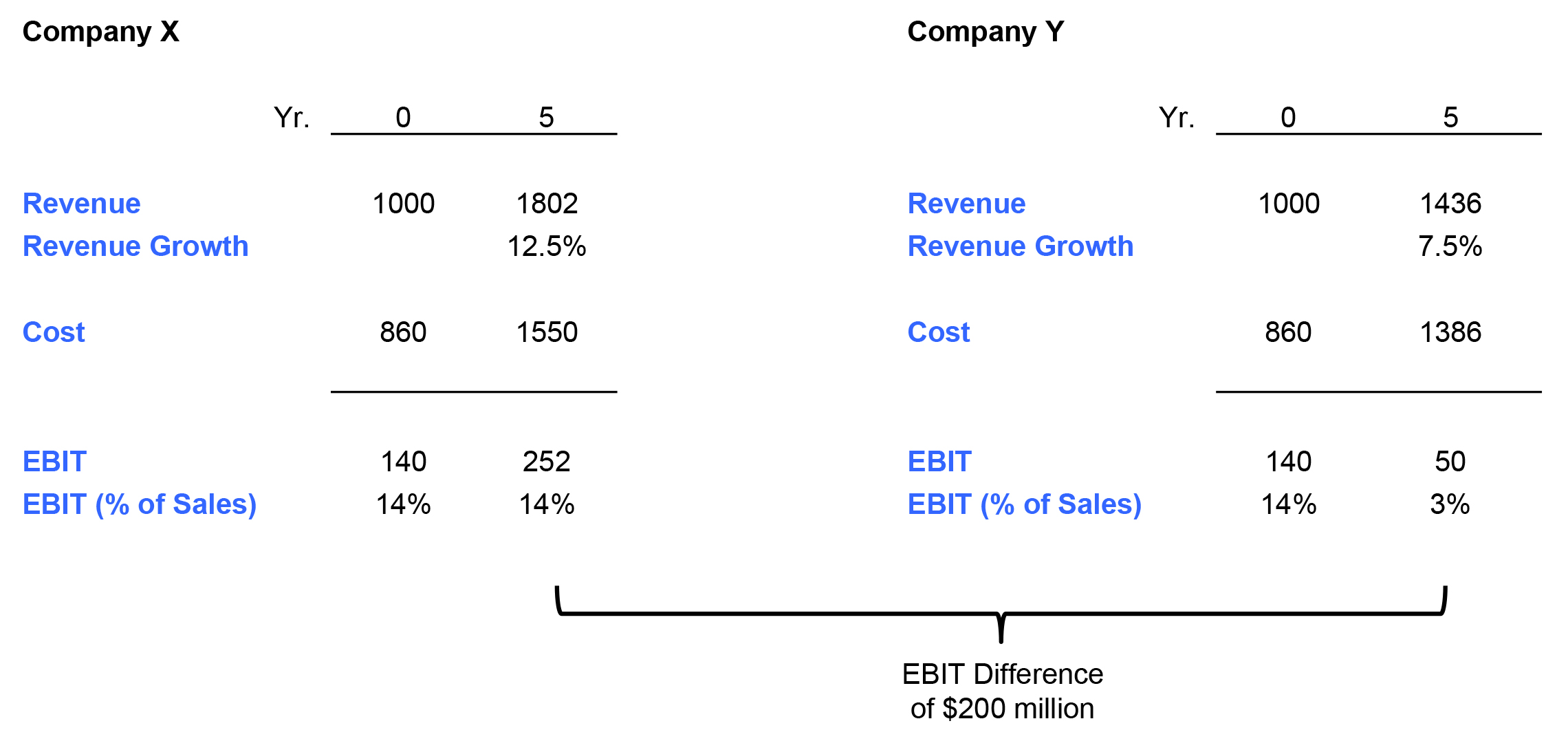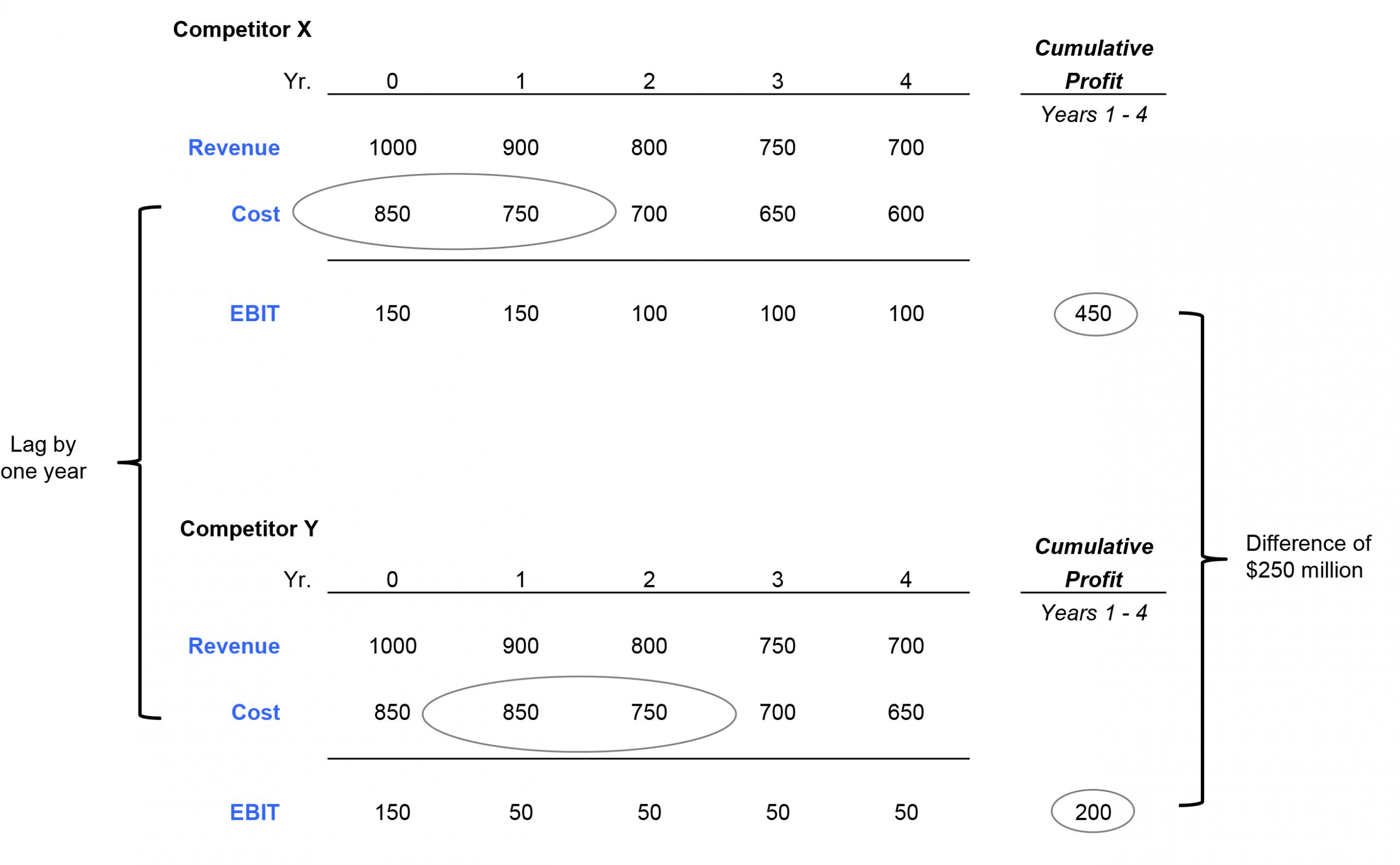We have moved into an era where the success of a business strategy depends just as much on the speed of execution as in identifying the right strategic direction. Rapid execution confers the ultimate competitive advantage to leaders and their organization and is the most powerful predictor of success for any strategic initiative. Ultimately, the speed of execution is a choice by the CEO, controlled entirely within the confines of the organization.
THE VALUE OF SPEED
Differences in the speed at which companies execute strategy determine differences in competitiveness and profitable growth. Two examples illustrate this concept.
Examples 1: Revenue Growth. Consider competitors X and Y, each with $1,000 million in sales and a margin of $140 million, in a market growing at 7.5% per year (Exhibit 1). Company X grows at 12.5% per year. Thanks to its increase in size, it lowers its prices to gain market share. In five years, the company reaches $1,800 million in sales and a margin of $250 million (at 14% of sales). Conversely, Company Y grows at 7.5% per year. In five years, it reaches $1,436 million in sales; however, it must lower its prices to follow the market leader. As a result, its margin drops to $50 million, i.e., 3% of sales. The net result is a difference in profit in year five of $200 million.
Exhibit 1. Comparative Revenue Growth

Example 2: Cost Reduction. Imagine competitors X and Y, each at $1,000 million in revenue, a margin of $150 million, experiencing declining growth (Exhibit 2). Company X starts an aggressive cost reduction program and decreases cost every year for the next four years. Company Y executes a similar cost reduction program, but starts one year later. The net result is a difference of cumulative profit of $250 million. The relative speed in executing the cost reduction program makes a significant difference.
Exhibit 2. Comparative Cost Reduction

In both examples, rapid execution is intrinsic to the value of the strategy. Not only is timing crucial, but so are the strategic levers that become available with speed of execution.
THE STRATEGIC LEVERAGE OF SPEED
Rapid execution confers a wide array of strategic capabilities and competitive advantages to the firm.
Strategic Capabilities: With rapid execution, many strategic capabilities become available to the firm, including the following:
- Creating slack resources, i.e., cost savings, cash, planning time
- Learning fast and adjusting rapidly to market conditions
- Gaining customer insights quickly
- Carving out a strategic position
- Seizing opportunities in real time as they present themselves
- Lowering the break-even point in sync with the economic cycle of the industry
Competitive Advantage: Executing a strategy faster than competitors confers various types of competitive advantage as follows:
- First-mover advantage in seizing an opportunity
- Setting the pace of change for the market
- Iterating and improving your product more quickly than your rivals
- Extending and maintaining a time-lead over the next competitor
- Generating excess returns before imitators begin to erode margins
- Creating a time window to pre-empt scarce assets and lock up channels
With rapid execution, a company increases the likelihood of success in implementing a strategy and also
gains access to unique strategic levers that competitors don’t have, widening its range of play.
WHAT IT TAKES
The speed of execution is a management choice and entirely within its control. Activate the following levers to expedite implementation:
- Prioritize few strategic initiatives: The problem with strategic initiatives is that all too often they are not strategic. Strategic initiatives are not “business as usual.” Strategic initiatives are not just “new” organizational efforts being taken on. Strategic initiatives are actions designed to help the organization achieve its strategy. Make these actions few, specific, measurable, achievable, results oriented, time framed and resourced.
- Focus on the right critical success factors: Getting the right critical success factors (CSFs) is fundamental to strategy execution. Once the CSFs are crystallized, all subsequent activities cascade from there, including resource allocation, performance management, monitoring, and strategic control. Get the right CSFs, and your organization will succeed; if not, the business strategy will fall apart.
- Adopt a flat organization: Aim for a lean structure to reflect the strategy closely. A slim organizational design builds on a few management layers, i.e., a small number of levels between the CEO and the frontline of the company. This design allows the company to follow a strategy more closely and dramatically improves the odds of successful execution.
- Allocate the necessary resources: Anticipate the need to reinforce your business to support your strategy, and make the appropriate investments to ensure that the plan has an impact. For instance, a company that wants to accelerate its growth needs to invest significantly more than its competitors. Focus on the necessary capital expenses, operating expenses, and human resources.
- Align people: Set clear roles and explicit accountabilities for all the people involved. Explicit accountabilities are the set of practices and systems designed to achieve individual and group performance. Use them as the basis for every working relationship in the organization and achieve five advantages: productivity, performance, alignment, feedback, and development.
- Maintain controls: Use strategic controls to track progress toward the fulfillment of the strategy or confirm its continued validity and take corrective action as needed. The objective is to act on time while the strategy execution is taking place, by steering the company toward the intended strategic and operational goals.
CONCLUSION
Incumbent companies often believe they have more time to execute their strategies than their rivals because of their established position in the market. Nothing could be further from the truth. In today’s markets, data analytics, business intelligence, digital value chains, e-businesses, artificial intelligence, smart products, smart machines, the“internet of things” and cloud software equalize the chances of success for everyone. To keep up, incumbents need to move just as fast as their competitors, big or small.
Rapid execution is essential to the success of a strategy. Make it work through focus and simplicity: concentrate on a few initiatives, get the right critical success factors in place, adopt a simple organization, allocate the necessary resources, use explicit accountabilities, and maintain strategic control.
Can you execute your strategy rapidly?
What is your speed of execution?

